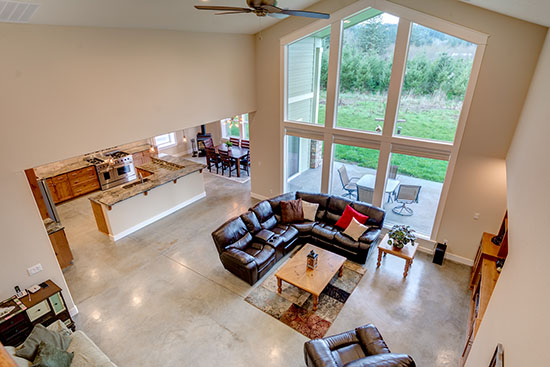|
Subscribe / Renew |
|
|
Contact Us |
|
| ► Subscribe to our Free Weekly Newsletter | |
| home | Welcome, sign in or click here to subscribe. | login |
Construction
| |
 |
May 9, 2017
Residential concrete

Nelson Residence
Location: Amboy, Clark County
Owner/developer: Josh and Laura Nelson
Team: Design Doctors Construction, general contractor; Alite Construction, concrete contractor; Vision Designs, architect; Banton Engineering, structural engineer; CalPortland, ready-mix supplier
Josh Nelson has been in the concrete industry his entire working life, and his wife, Laura, works at Lakeside Industries.
So when it became apparent that the manufactured home they lived in was actually meant to be temporary, the Nelsons decided concrete was going to be the main material used to build their permanent home.
The Nelsons wanted a low-maintenance, one-level home that would be secure and energy efficient. They elected to go with an ICF home with radiant heat in the slab on grade.
Using an experienced engineer, the Nelsons went about selecting a general contractor, but also did a significant amount of work themselves. Once the 22 yards for the footings were in, Josh assembled a crew of various ready-mix people he had worked with over the years.
The first day they assembled almost half of the house. After they went back to their day jobs, the general contractor completed stacking the walls, inserting the rebar and erecting the bracing system.
When pour day came, it took about five hours to place the 59 yards in the 6-inch-thick walls. A proven pea gravel mix was placed at about a 7-inch slump. Vibration was used where needed, mostly around doors and windows.
Once the walls cured and the bracing was removed, rock was placed and compacted to support the slab.
An EZ Floor system was used, providing insulation, vapor barrier and a plastic tube placement system in one step. The interior slabs would take another 58 yards, this time using a 6.5-sack mix with super plasticizer to allow placement at a 7-inch slump. The slab was then water cured — that is, until the well went dry in the late September heat.
Since the Nelsons love the look of concrete, they did not go for any colors or fancy polishing on the interior slabs — just a hard trowel finish, and they applied a water-based sealer to enhance and protect the natural beauty of the slab.
As the general contractor got the house dried in with the roof on and completed the interior finishes, the Nelsons placed another 58 yards in exterior concrete using a large rock six-sack mix with air and mid-range water reducer for the driveway.
The patio, porch, and walkways used a mix with a higher sand content for a sand finish. This included a broadcast of silicon carbide.
Silicon carbide is one of the latest techniques in decorative concrete to add pizazz to concrete, bringing out a real sparkle effect that changes with different lighting. It also makes the surface non-slip, which is important in the wet Northwest.
Attached to the structure is a large covered patio. Sustainable features include the ICF walls, slab-on-grade radiant heat with abundant insulation, low-maintenance concrete floors, and a reflective concrete driveway with simple decorative effects on the walkway surfaces.
The Nelsons now have twice the house with half the energy bills they had when living in the old manufactured home.
Other Stories:
- Grand Award
Public works: Bridges - Special applications: Resiliency
- Community Award
- Concrete paving
- Pervious concrete
- Artistic and decorative concrete
- Public works: Renovations
- Public Works: Infrastructure
Sustainable Merit - Cast-in-place structures
- Cast-in-place structures: Parking garage
Special applications: Technical merit (tie) - Tilt-up structures
- Special applications: Technical merit (tie)


